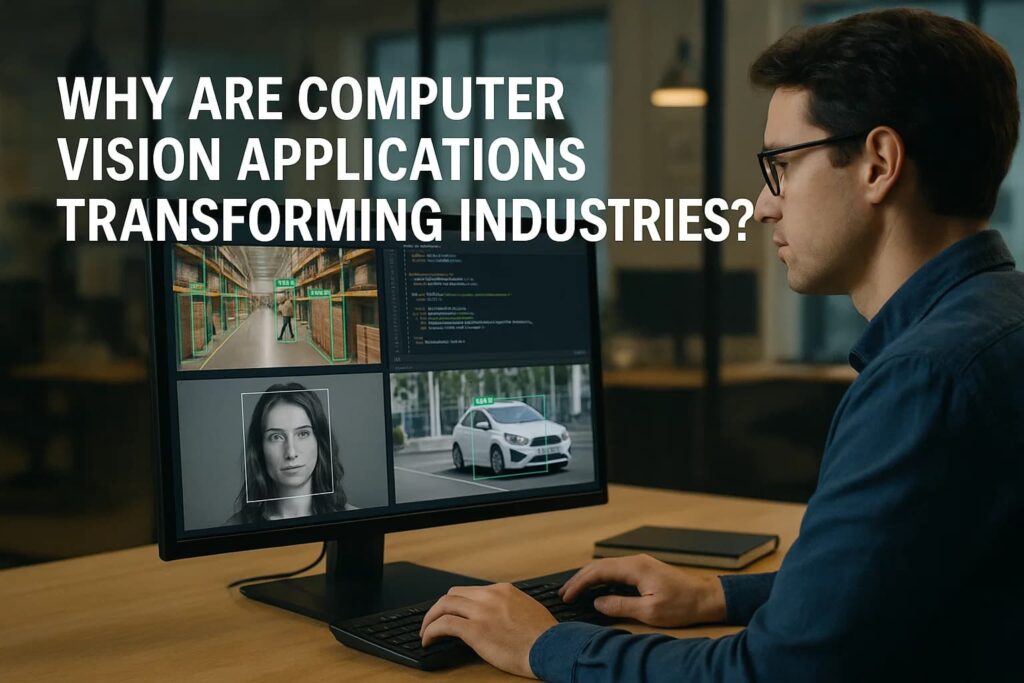
Best video cards and PC specs for 4K gaming
Keen to unlock true 4K gaming performance? Discover which video cards and PC specs deliver stunning visuals—your ultimate setup awaits just ahead.

Computer vision is transforming industries by automating tasks that once depended on human perception. It helps businesses boost efficiency, accuracy, and safety across areas like healthcare and urban planning. The impact is wide, but what really matters are the specific changes happening now. Check the text below to explore them.

By leveraging advanced algorithms, computer vision is transforming healthcare diagnostics and patient monitoring.
In diagnostic imaging, computer vision enables automated detection of anomalies in X-rays, MRIs, and CT scans, improving accuracy and efficiency.
For patient monitoring, these systems analyze real-time video feeds, tracking essential signs and movements, thereby alerting clinicians to potential issues sooner and supporting more effective, data-driven medical decision-making in clinical environments.
Beyond healthcare, computer vision plays a significant role in advancing automotive safety and enabling autonomous driving technologies. By interpreting real-time visual data, vehicles can perform autonomous navigation, detect obstacles, and provide timely collision detection. This leads to safer roads and reduces human error, as demonstrated below:
| Feature | Function | Impact |
|---|---|---|
| Autonomous Navigation | Route Planning | Enhanced Mobility |
| Collision Detection | Object Recognition | Accident Reduction |
| Lane Departure Alert | Lane Monitoring | Road Safety |
As industrial processes grow increasingly complex, computer vision has become integral to smart manufacturing and quality control.
By leveraging machine learning, automated visual inspection systems can rapidly identify defects, monitor assembly lines, and guarantee product consistency with remarkable accuracy.
This technology minimizes human error, reduces waste, and streamlines operations, enabling manufacturers to maintain high standards while adapting to evolving production demands and market requirements.
Computer vision is also reshaping the retail sector through automated checkout solutions and advanced analytics.
These innovations streamline operations and enhance the shopping experience by leveraging real-time data.
Key applications include:
Surveillance technology has evolved rapidly with the integration of computer vision, enabling more accurate and efficient monitoring of public and private spaces.
Automated systems now utilize facial recognition to identify individuals, enhancing access control and locating persons of interest.
Advanced threat detection algorithms analyze video feeds in real-time, alerting security personnel to suspicious activities.
This transformation supports proactive responses, improving safety and reducing human error in surveillance operations.
Beyond enhancing security, computer vision technologies are making significant strides in agriculture by enabling precise, data-driven monitoring of crops and livestock.
These innovations transform traditional farming through:
A growing array of sports organizations and teams are leveraging computer vision to extract actionable insights from athlete movement, game footage, and biometric data. This technology enables real-time data visualization and objective evaluation of player performance, leading to informed coaching decisions.
| Application | Benefit |
|---|---|
| Player Performance Tracking | Enhanced analysis |
| Game Footage Analysis | Tactical improvements |
| Biometric Data Integration | Injury prevention |
Transforming the movement of goods from origin to destination, computer vision streamlines logistics and supply chain operations through automated inventory tracking, real-time shipment monitoring, and quality control inspections.
Key contributions include:
Urban environments benefit considerably from computer vision technologies, which provide actionable insights for city management and planning.
By analyzing real-time data from cameras and sensors, these systems enhance urban mobility through optimized traffic flow and public transportation monitoring.
Additionally, computer vision enables infrastructure optimization by detecting maintenance needs, monitoring crowd densities, and supporting resource allocation, all of which contribute to safer, more efficient, and well-organized urban spaces.
While traditional methods of environmental monitoring often rely on manual surveys and limited sampling, computer vision offers scalable, automated solutions for tracking ecological changes and wildlife populations.
These technologies enhance research and conservation by:
Computer vision applications are fundamentally reshaping diverse industries by automating complex tasks, increasing accuracy, and enabling real-time insights. From healthcare and automotive to manufacturing, retail, and environmental monitoring, these technologies drive efficiency, safety, and innovation.
As computer vision continues to advance, its transformative impact is expected to expand further, revealing new possibilities and solutions across sectors. Ultimately, these advancements not only optimize operations but also contribute to improved outcomes and enhanced quality of life worldwide.

Keen to unlock true 4K gaming performance? Discover which video cards and PC specs deliver stunning visuals—your ultimate setup awaits just ahead.

Before buying a new video card, discover the crucial steps to ensure compatibility with your motherboard—one mistake could cost you.

Curious why gaming graphics cards cost so much? Complex tech and market twists mean there’s more behind the price than you might think.

On the fence about upgrading your gaming laptop's graphics card? Discover what's truly possible before you make your next move.

Considering a hardware upgrade? Check out which PC brands make swapping components a breeze—and discover the standout choice you might not expect.

Discover the top three warning signs your computer may be infected with malware, and see if your device is secretly at risk.